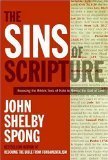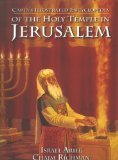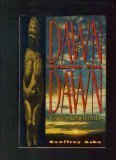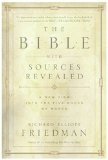Lee Harmon's Blog, page 135
March 18, 2011
Luke 24:27, Moses wrote the Torah
And beginning with Moses and all the Prophets, he explained to them what was said in all the Scriptures concerning himself.
//Moses did not write the first five books of the Bible. The Documentary Hypothesis in one form or another is nearly undisputable, as I described a few days ago in a book review: http://www.dubiousdisciple.com/2011/03/book-review-bible-with-sources-revealed.html . Moses died three hundred years before the first verse of the Torah was written. These five books reflect multiple strands of material that were put together over a period of at least five hundred years. One of these books even contains the account of Moses' death and burial; a remarkable thing for Moses to write about!
Yet, Jesus himself makes the traditional claim for Mosaic authorship of the Torah in several places. Here are two, each found in multiple Gospels:
Mark 1:44, "See that you don't tell this to anyone. But go, show yourself to the priest and offer the sacrifices that Moses commanded for your cleansing, as a testimony to them."
Matthew 19:7-8, "Why then," they asked, "did Moses command that a man give his wife a certificate of divorce and send her away?" Jesus replied, "Moses permitted you to divorce your wives because your hearts were hard. But it was not this way from the beginning.
What can we conclude? That Jesus didn't really say these things? That Jesus was wrong about the Torah's authorship? That Jesus knew better but found no reason to contradict popular belief? Or could current scholarship be wrong, and Moses did write the Torah?
//Moses did not write the first five books of the Bible. The Documentary Hypothesis in one form or another is nearly undisputable, as I described a few days ago in a book review: http://www.dubiousdisciple.com/2011/03/book-review-bible-with-sources-revealed.html . Moses died three hundred years before the first verse of the Torah was written. These five books reflect multiple strands of material that were put together over a period of at least five hundred years. One of these books even contains the account of Moses' death and burial; a remarkable thing for Moses to write about!
Yet, Jesus himself makes the traditional claim for Mosaic authorship of the Torah in several places. Here are two, each found in multiple Gospels:
Mark 1:44, "See that you don't tell this to anyone. But go, show yourself to the priest and offer the sacrifices that Moses commanded for your cleansing, as a testimony to them."
Matthew 19:7-8, "Why then," they asked, "did Moses command that a man give his wife a certificate of divorce and send her away?" Jesus replied, "Moses permitted you to divorce your wives because your hearts were hard. But it was not this way from the beginning.
What can we conclude? That Jesus didn't really say these things? That Jesus was wrong about the Torah's authorship? That Jesus knew better but found no reason to contradict popular belief? Or could current scholarship be wrong, and Moses did write the Torah?
Published on March 18, 2011 06:29
March 17, 2011
Book review: The Sins of Scripture

 by John Shelby Spong
by John Shelby Spong★★★★★
The subtitle of this book is Exposing the Bible's Texts of Hate to Reveal the God of Love. I read this book a few years back, and the reason it came to mind today is because I am feeling overwhelmed by the aggressiveness of anti-Bible crusaders. Unquestionably, there are many passages in the Bible that are not only questionable theology, but downright appalling. Unquestionably, there are "Christians" today who pounce on these texts in order to promote discrimination or oppression. But the majority of Christians do not; the majority of Christians worship a God of love, and either spiritualize or completely discard those scriptures that reveal, not God's will, but human weakness.
Can we really worship a God who murdered all the firstborn males in every Egyptian household? How about a God who stops the sun in the sky, providing more daylight so that Joshua can slaughter more of his enemies? Would the God you worship instruct Samuel to "Go and smite Amalek, and utterly destroy all that they have; do not spare them, but kill both man and woman, infant and suckling, ox and sheep, camel and ass"?
Is it ok to possess slaves, or sell your daughter into slavery? Should cursing or violating the Sabbath be cause for death? Is it right to stone disobedient children? Of course not, neither today or 2,500 years ago, and we know this.
How about the treatment of women as chattel? Encouragement of homophobia? Anti-Semitism? Spong guides us into a more liberal understanding of the Bible, pointing out the texts that exhibit human thinking, human fear, and comparing them to texts where the love of God shows through, and briefly touching on his vision of the Kingdom of God. It's true that this book is one of the more negative of Spong's works, but it sets us up for books yet to come.
(click picture to buy on Amazon)
Published on March 17, 2011 06:26
March 16, 2011
1 John 5:7-8, the Comma Johanneum
For there are three that bear record in heaven, the Father, the Word, and the Holy Ghost: and these three are one. And there are three that bear witness in earth, the Spirit, and the water, and the blood: and these three agree in one.
//This is one of the most intriguing passages in the Bible, and the source of some very heated arguments. It's called the Comma Johanneum, and it doesn't exist.
The above quotation comes from the King James Version. Problem is, it exists in none of the earliest manuscripts of the Bible, nor was it mentioned by any of the early church fathers when they quoted this portion of scripture. (No, Cyprian of Carthage did not quote the verse with the inserted Comma in the year 250!) The center of the passage appears to have added to the Latin text of the New Testament sometime during the middle ages. Commentators are virtually unanimous that it was added to the Bible in light of Trinitarian debates. The original wording is:
For there are three that bear record, the Spirit, and the water, and the blood: and these three agree in one.
Inserted in the middle is an explicit reference to the Trinity of Father, Son and Holy Ghost. Had the passage been original, there appears to be no good reason for it to have later disappeared. Many current translations, such as the NIV and the NSRV, now omit it, and the Vatican appears to approve. In 1927, Pope Pius XI decreed that the Comma was open to dispute, and the updated New Vulgate, published in 1979 following the Second Vatican Council, does not include the Comma.
Yet a number of recent fundamentalist movements advocate the superiority of the King James Version, and refuse to consider the possibility that the verse is inauthentic. For many, rejecting the Comma is tantamount to claiming that God did not have a hand in the translation of the KJV.
The argument continues. Ain't religion fun?
//This is one of the most intriguing passages in the Bible, and the source of some very heated arguments. It's called the Comma Johanneum, and it doesn't exist.
The above quotation comes from the King James Version. Problem is, it exists in none of the earliest manuscripts of the Bible, nor was it mentioned by any of the early church fathers when they quoted this portion of scripture. (No, Cyprian of Carthage did not quote the verse with the inserted Comma in the year 250!) The center of the passage appears to have added to the Latin text of the New Testament sometime during the middle ages. Commentators are virtually unanimous that it was added to the Bible in light of Trinitarian debates. The original wording is:
For there are three that bear record, the Spirit, and the water, and the blood: and these three agree in one.
Inserted in the middle is an explicit reference to the Trinity of Father, Son and Holy Ghost. Had the passage been original, there appears to be no good reason for it to have later disappeared. Many current translations, such as the NIV and the NSRV, now omit it, and the Vatican appears to approve. In 1927, Pope Pius XI decreed that the Comma was open to dispute, and the updated New Vulgate, published in 1979 following the Second Vatican Council, does not include the Comma.
Yet a number of recent fundamentalist movements advocate the superiority of the King James Version, and refuse to consider the possibility that the verse is inauthentic. For many, rejecting the Comma is tantamount to claiming that God did not have a hand in the translation of the KJV.
The argument continues. Ain't religion fun?
Published on March 16, 2011 06:42
March 15, 2011
Book review: How the Bible Came to Be

 by John Barton
by John Barton★★★★
John Barton spent 15 years studying the making of the Bible. This brief booklet (less than 100 pages) presents his findings. He first gives a short synopsis of each of the 66 books of the Bible, and then dives into probable authorship and dating. From there, he discusses how the books were selected and collected into scripture, including an interesting discussion of what was considered "scripture." Finally, he explains how the two canons (Old Testament and New) were derived.
Barton is not going to tell you Paul wrote Hebrews or that Moses wrote the Torah. His purpose is not to present traditional, conservative teachings, but to bring you up to date on current Bible scholarship, and he writes in a manner that non-technical readers can comprehend. There is no unified understanding between scholars, and some of Barton's views are his own, yet all in all I think he does a great job of introducing the formation of the Bible.
In my opinion, the book's greatest value is for conservative Christians! If you don't want to spend weeks learning about biblical scholarship, but need to be aware of the thinking and conclusions of critical scholarship, this is a perfect overview. Two hours will give you the basics.
(click picture to buy on Amazon)
Published on March 15, 2011 07:05
March 14, 2011
Ezekiel 28:12-13, the location of Eden
You were in Eden, the garden of God; every precious stone adorned you: ruby, topaz and emerald, chrysolite, onyx and jasper, sapphire, turquoise and beryl. Your settings and mountings were made of gold; on the day you were created they were prepared. You were anointed as a guardian cherub, for so I ordained you. You were on the holy mount of God; you walked among the fiery stones.
//In these verses, God reminds the Son of Man that he once walked in Eden. This Eden, says God, was on his "holy mount." Ezekiel is not alone in this: the myths of several early civilizations located an ancient paradise atop a great mountain to the north. But nowhere else in scripture is Eden located on any mountain, and this doesn't seem to square with Genesis 2, where Eden is situated among four rivers: the Pishon, the Gihon, the Tigris, and the Euphrates.
So where does Genesis place Eden? The Tigris and Euphrates are located in Mesopotamia. Gihon, says Genesis, flows "around the whole land of Cush," which is Ethiopia, so perhaps Gihon is the Nile. Pishon is unknown, but strong tradition makes it the Ganges, in India. Huh?? We're not exactly zeroing in.
What's often missed in the Genesis story, though, is that Eden is not cradled within these four rivers but is the source of the rivers. They apparently flow from Eden over distances of thousands of miles. One might say their purpose is to water the entire known earth. In other words, everywhere is downhill from Eden!
Before splitting into four streams and tumbling down the mountain of God, the river feeds a garden. There, God walks. There, paradise waits for a better time, when God himself will again dwell with his people. There, we can imagine high above the plains, heaven and earth meet.
//In these verses, God reminds the Son of Man that he once walked in Eden. This Eden, says God, was on his "holy mount." Ezekiel is not alone in this: the myths of several early civilizations located an ancient paradise atop a great mountain to the north. But nowhere else in scripture is Eden located on any mountain, and this doesn't seem to square with Genesis 2, where Eden is situated among four rivers: the Pishon, the Gihon, the Tigris, and the Euphrates.
So where does Genesis place Eden? The Tigris and Euphrates are located in Mesopotamia. Gihon, says Genesis, flows "around the whole land of Cush," which is Ethiopia, so perhaps Gihon is the Nile. Pishon is unknown, but strong tradition makes it the Ganges, in India. Huh?? We're not exactly zeroing in.
What's often missed in the Genesis story, though, is that Eden is not cradled within these four rivers but is the source of the rivers. They apparently flow from Eden over distances of thousands of miles. One might say their purpose is to water the entire known earth. In other words, everywhere is downhill from Eden!
Before splitting into four streams and tumbling down the mountain of God, the river feeds a garden. There, God walks. There, paradise waits for a better time, when God himself will again dwell with his people. There, we can imagine high above the plains, heaven and earth meet.
Published on March 14, 2011 07:07
March 13, 2011
Book review: Carta's Illustrated Encyclopedia of the Holy Temple in Jerusalem

 by Israel Ariel and Chaim Richman
by Israel Ariel and Chaim Richman★★★★★
Rabbis Ariel and Richman represent the Temple Institute, founded in 1988 to "rekindle the flame of the Holy Temple in the hearts of mankind." It houses a team of researchers of Temple-related subjects. This oversized book is a product of the Institute.
This is a reverent and stunningly beautiful coffee-table book, containing hundreds of pictures, richly annotated. I bought this while in Jerusalem, and I absolutely love it; no other book I've seen so evinces such a feeling of the Temple's original splendor and atmosphere.
The subject is, of course, Herod's Temple, the Temple visited by Jesus. Christians seem to have mixed feelings about the Temple and its rituals, but if you want to view its place in history from a Jewish viewpoint—including the sacred stories that preceded its building upon holy land—this book is a treasure. You'll learn about Temple services, the sacred artifacts, the roles of both men and women, and the special ceremonies of the feast days of Rosh Hashanah, Yom Kipper, Sukkot, the Passover, and Shavuot. (For the uninitiated, these are the festivals of the New Year, the Day of Atonement, the Feast of Booths/Tabernacles, the Passover, and the Feast of Weeks.)
(click picture to buy on Amazon)
Published on March 13, 2011 09:24
March 12, 2011
1 Thess 5:2-3, Christ comes as a thief
for you know very well that the day of the Lord will come like a thief in the night. While people are saying, "Peace and safety," destruction will come on them suddenly, as labor pains on a pregnant woman, and they will not escape.
//Paul's teaching in the first letter to the Thessalonians promises that the coming of Christ is imminent, and will arrive suddenly and unexpectedly. Paul indicates that some of his audience will still be alive by the time Christ appears. But before the second letter to the Thessalonians is written, Paul seems to change his mind:
Now concerning the coming of our lord Jesus Christ and our assembling to meet him, we beg you, brethren, not to be quickly shaken in mind or excited, either by spirit or by word, or by letter purporting to be from us, to the effect that the day of the Lord has come.
Many scholars believe this second letter was not written by Paul. This difference in urgency between I and II Thessalonians provides the primary reason many remain convinced of the second epistle's pseudonymity. In the first letter, Paul insists the end is near, so the Thessalonians need to remain vigil. In the second letter, "Paul" has apparently changed his mind, now arguing the coming of Christ will be delayed, not to occur until after a number of clear-cut signs serve as a warning.
Unless Christ has come back, the first letter to the Thessalonians was simply wrong. Might the second letter have a better track record? In light of recent world disasters, I leave you with this question: have the clear-cut warnings of "Paul" been fulfilled?
//Paul's teaching in the first letter to the Thessalonians promises that the coming of Christ is imminent, and will arrive suddenly and unexpectedly. Paul indicates that some of his audience will still be alive by the time Christ appears. But before the second letter to the Thessalonians is written, Paul seems to change his mind:
Now concerning the coming of our lord Jesus Christ and our assembling to meet him, we beg you, brethren, not to be quickly shaken in mind or excited, either by spirit or by word, or by letter purporting to be from us, to the effect that the day of the Lord has come.
Many scholars believe this second letter was not written by Paul. This difference in urgency between I and II Thessalonians provides the primary reason many remain convinced of the second epistle's pseudonymity. In the first letter, Paul insists the end is near, so the Thessalonians need to remain vigil. In the second letter, "Paul" has apparently changed his mind, now arguing the coming of Christ will be delayed, not to occur until after a number of clear-cut signs serve as a warning.
Unless Christ has come back, the first letter to the Thessalonians was simply wrong. Might the second letter have a better track record? In light of recent world disasters, I leave you with this question: have the clear-cut warnings of "Paul" been fulfilled?
Published on March 12, 2011 07:21
March 11, 2011
Book review: Dawn Behind the Dawn

 by Geoffrey Ashe
by Geoffrey Ashe★★★
SPOILER ALERT
Seven. Seven, 7, seven. Most of the book is taken up with this mystical number, a number with little practicality to explain its lofty status. Our seven-day week, for example, derives directly from the Hebrew reverence for this number, but it's clumsy; seven divides neatly into neither a 30-day month nor a 365-day year. Why not a five-day week?
As a scholar of Revelation, I'm certainly familiar with the number seven. Seven churches, seven seals, seven angels, seven trumpets, seven bowls of wrath, seven-headed dragons, and more. The number seven bleeds into the Gospel of John as well, with seven I AM's and seven signs. But the mysticism of this number precedes Hebrew beliefs and is inexplicably common throughout several civilizations, dating back thousands of years.
The subtitle of Ashe's book is "A Search for Earthly Paradise," and while the analysis of the number seven is interesting, it isn't worth half the book; it doesn't bring us very close to paradise. More interesting is the author's research into shamanism and the various myths of a northern mountain paradise, an exalted Eden.
In the end, uncovering an earthly paradise is revealed to be too lofty a goal; at best, the most the author uncovers is a distant memory of a golden age of female shamans, with implications about a cultural source or seedbed somewhere between Siberia and Mongolia, which may have been a sort of paradise of Goddess wisdom. By book's end, even this has dissolved into a number of obscure theories about the origins of our myths and mystical numbers. I'm afraid paradise is forever lost, my friends.
(click picture to buy on Amazon)
Published on March 11, 2011 08:23
March 10, 2011
1 Thess 4:17, the Parousia
After that, we who are still alive and are left will be caught up together with them in the clouds to meet the Lord in the air. And so we will be with the Lord forever.
//Virtually all Christians picture the parousia as an event where God-fearers are lifted up to heaven, to dwell with the Lord. Artwork abounds of this glorious moment, and the picture seems to match the verse above. But is that really what Paul meant? Let's look at the meaning of the Greek words parousia, the arrival of Christ, and his apantesis, or reception, as used by Paul in Thessalonians to describe how the Christians will meet Jesus in the air.
Picture a king arriving as a visitor to a city. A cluster of citizens, a welcoming committee, go out to meet him, and escort him into the city. This is precisely how these Greek words are used elsewhere.
Perhaps we should turn to Revelation for clarification. In the Revelation story, the parousia occurs just before Christ begins his 1,000 year reign on earth. In other words, if we are to be "with the Lord forever" from that moment on, new life will at least begin on earth, not up in the sky.
So what are we doing up in the clouds, according to Revelation? Well, the New Jerusalem is about to float down to earth, and it is referred to as the bride of Christ. The adornment of the bride, as it settles upon Mount Zion, is God's people. Thus, we can conclude that in the parousia, we fly up to the sky, welcome Jesus to earth, enter the New Jerusalem, and float back down inside the city of God.
Yes, I know this is very different than current Christian theology. I don't make this stuff up!
//Virtually all Christians picture the parousia as an event where God-fearers are lifted up to heaven, to dwell with the Lord. Artwork abounds of this glorious moment, and the picture seems to match the verse above. But is that really what Paul meant? Let's look at the meaning of the Greek words parousia, the arrival of Christ, and his apantesis, or reception, as used by Paul in Thessalonians to describe how the Christians will meet Jesus in the air.
Picture a king arriving as a visitor to a city. A cluster of citizens, a welcoming committee, go out to meet him, and escort him into the city. This is precisely how these Greek words are used elsewhere.
Perhaps we should turn to Revelation for clarification. In the Revelation story, the parousia occurs just before Christ begins his 1,000 year reign on earth. In other words, if we are to be "with the Lord forever" from that moment on, new life will at least begin on earth, not up in the sky.
So what are we doing up in the clouds, according to Revelation? Well, the New Jerusalem is about to float down to earth, and it is referred to as the bride of Christ. The adornment of the bride, as it settles upon Mount Zion, is God's people. Thus, we can conclude that in the parousia, we fly up to the sky, welcome Jesus to earth, enter the New Jerusalem, and float back down inside the city of God.
Yes, I know this is very different than current Christian theology. I don't make this stuff up!
Published on March 10, 2011 07:55
March 9, 2011
Book review: The Bible With Sources Revealed
 by Richard Elliott Friedman
by Richard Elliott Friedman★★★★
The first five books of the Bible are traditionally understood to have been written by Moses. In places, Jesus appears to confirm this. Most critical Bible scholars since the late 19th-century, however, have recognized at least four different contributors of the books of Moses:
A text known as J was composed during the period when the kingdoms of Israel and Judah were divided. J was written by an author living in the southern kingdom. It's known as J because it refers to God by the name of YHWH (Jahwe in German).
A second text known as E was composed in the same period, by a priest living in the northern kingdom. It's called E because it refers to God as Elohim.
A third text is known as P because it concerns the priesthood. There remains some argument about when it was composed; Friedman suggests shortly after J and E were combined into one text.
The final source is known as D because it comprises most of the book of Deuteronomy. It's part of a longer work, including Joshua, Judges, 1 and 2 Samuel, and 1 and 2 Kings. It contains sources that date as early as J and E, but it was not compiled into one source until the reign of King Josiah, circa 622 BC.
All of these sources were spliced together by a redactor to create the Torah (the first five books of the Bible). Friedman discusses the evidence for this theory (called the Documentary Hypothesis), and then travels verse by verse through the Torah, color-coding the source and footnoting the setting. You'll recognize two distinct creation stories in the Bible and two flood stories, and conflicting accounts within the Bible will suddenly make more sense, as the source and motive of the writings are revealed.
It's best used as a reference book—I certainly haven't read it straight through—but it's a book I refer to often.
(click picture to buy on Amazon)
Published on March 09, 2011 07:00



